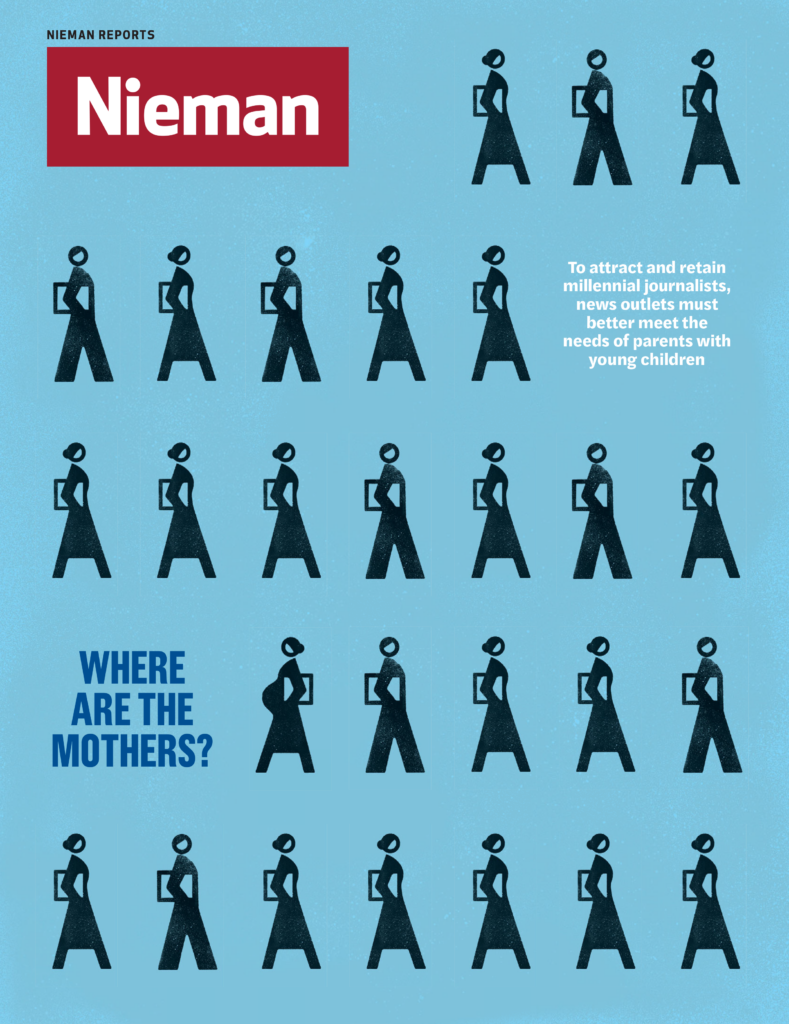
“We’re having a bit of a baby boom,” says Lauren Williams, executive editor of Vox.com and the mother of an 18-month-old. When the news startup began in 2014, there wasn’t a single parent working at the site. But as the website has grown, so have employees’ families. Now, around 15 percent of the 90-person staff have children.
Margaret Wheeler Johnson, who has a 2-year-old and an infant, was the first person to have a baby while working at Bustle.com, a startup women’s site. She’s now managing editor of Romper.com, owned by the same company, a site for millennial moms that is also experiencing a surge in new children among staff.
“We’re all in that early- to mid-30s life shift,” is how Kate Sheppard, with a 20-month-old son, describes the leaders of HuffPost’s Washington, D.C. bureau. Three quarters of the senior staff have children under 2.
“Any company that wants to employ millennials needs to address this,” says Laura Wides-Muñoz, mother of a 7- and an 8-year-old and vice president of special projects and editorial strategy at Fusion. She’s seen a wave of new parents enter her workplace. In contrast to even 10 years ago, she’s noticed these staffers have often been more upfront about their parenting realities and more vocal about their desire for better policies. “I think it’s a positive development,” she says.
In the conversation about how to create more diversity and gender balance in newsrooms, one group has been routinely ignored: mothers. What are newsrooms doing to retain women who have or plan to have children, to make sure more women stay in the talent pipeline?
Related Reading
While legacy news organizations have had some working mothers and (sometimes less than ideal) family leave policies for many decades, for a certain set of younger digital news organizations, this is all unfolding in real time. What happens when the people who took blogging mainstream in the mid-2000s, and who now hold demanding jobs in national news, start to have babies? A recent Pew study puts the median age for a first child among highly educated women at 30, and one million millennial women (born between 1981 and 1997) are becoming mothers each year in America.
A 2015 University of Kansas study found female journalists were at higher risk of burnout and more plan to leave the industry than their male counterparts, citing a feeling of less support from their organizations. Their dissatisfaction with the field was, in part, attributed to women’s desires to balance work with family responsibilities.
How both legacy organizations, hungry for journalists with 21st-century skills, and startups with nascent HR policies handle this may determine how diverse news leadership and coverage is for decades to come. What follows is a four-point plan for helping women—and men—with young families better manage work and parenthood.

When I found out I was pregnant with my first child, I had been working for six months as a leader at a fast-paced news website. I was to be the first person on this digital team to be a parent. I’d spent my 20s deftly climbing the career ladder in digital journalism, reaching senior management positions at a young age. I had a loving and supportive husband, who was happy to go down a less intense career path while I was the breadwinner. I presumed after our son was born I would take 12 weeks of maternity leave and keep charging ahead in journalism.

My son, Asher, was born in July of 2015. There were the joyous moments—the discovery that listening to Stevie Wonder at full blast seemed to make Asher stop crying, and his love of making eye contact and cuddling. What wasn’t typical was, when my son was 6 weeks old, we took him for a follow-up appointment to a specialist because of a potential issue originally identified on a prenatal sonogram. My husband, Travis, and I were in the middle of laughing at a joke when the doctor with well-coiffed hair and a TV anchor smile came in with a somber look on his face.
We were shocked to learn that our son had a number of serious problems with his kidneys and would need surgery as soon as possible. What followed was a multi-week saga involving surgery, two hospitalizations, endless blood tests, and a spinal tap in the longest day of my life at the pediatric ER. I remember walking out of the hospital in a dress covered in a mixture of my son’s blood and urine. My eyes were glazed, but the clearest thought in my mind was, “I will never be the same person after this.”
I’m so grateful my son has recovered from those early ordeals, but as I prepared to go back to work, thoughts about his need for a second surgery loomed. Warnings about monitoring him for infections were sternly passed on by doctors, along with the directive that continuing to nurse him was “the best thing I could do for him.” Despite the traumas of Asher’s early life, I was back at my desk when my 12 weeks of maternity leave were up.
Many mothers find the early weeks and months of being back at work difficult. In the only developed country in the world with no requirement for paid maternity leave, the average length of maternity leave, when taken, was 10.3 weeks in 2006-2008, according to a federal study. A 2014 Careerbuilder.com survey found that 11 percent of working mothers took a maternity leave of two weeks or less. There’s some hope this could change in the near future—in the 2018 budget, President Trump included a proposal for six weeks of paid leave for all new mothers, fathers, and adoptive parents—but the current reality is far from ideal. And while my son’s health crises weren’t typical, there is not a parent on the planet who hasn’t dealt with some kind of acute stress, whether it’s a sleepless baby, colic, or the inability to find reliable and affordable childcare.
In the conversation about how to create more diversity and gender balance in newsrooms, one group has been routinely ignored: mothers
Although I was the first person within my digital news team to have a child, I started to notice something on social media that made me realize I wasn’t alone. More and more journalist colleagues from past jobs, acquaintances, and women I’d met at conferences over the years were starting to post pregnancy announcements, followed by that newborn photo with the blue and white hospital blanket. As I saw their sleeping infant photos or their anguished first-day-back-at-work posts I wondered: How do they manage the demands of this industry?
And, if all, most, or even many of the new mothers leave this business, who’s going to be left?
Increasingly, journalists are asking questions about how their own newsrooms and the industry at large can do better at creating policies that specifically support parents. Rebecca Ruiz asked journalists to report on the family-friendliness of their newsrooms for the Poynter Institute, and Melody Kramer, also for Poynter, has surveyed newsrooms’ family leave policies. Both efforts are important first steps in starting conversations and getting data on these issues. Additionally, journalists are bringing their unions into the conversation about better family leave policies and employer support for childcare needs. The Wall Street Journal’s editorial staff wrote a letter in March demanding more newsroom diversity, gender pay equity, and specific protections for the careers of parents. William Lewis, the CEO of Dow Jones, the parent company of The Wall Street Journal, recently released a statement about this, promising to address gender equality and other diversity issues at the paper, but did not mention mothers or parents specifically.

To research this article, I interviewed nearly 20 mothers at a wide variety of news organizations. I picked women who work in senior leadership or management positions: women who work in digital mediums and will have the most capacity to direct news coverage and story topics for years to come. I chose women who are fully immersed in newsroom environments and culture—editors, managers, strategists, assigners, and idea generators. I chose this group to get better insights into how newsrooms operate and what official and unofficial policies are in place to support them. In focusing specifically on how to retain mothers in the news industry, I hope to promote solutions for tackling the pernicious gender gap in journalism. Most women spoke to me on the record, but some asked for their names to not be used when discussing sensitive workplace situations that could upset current or former employers.

While the women I spoke with earned more than many working mothers, they also frequently lived in expensive metropolitan areas, like New York or Washington, D.C. with some of the highest housing and childcare costs in the nation. While financial resources undoubtedly relieve many kinds of parenting stress, education and salary doesn’t seamlessly translate to an easier experience for working mothers. A Pew study found that 65 percent of parents with college degrees found it tough to balance family and job responsibilities, compared to 49 percent of non-graduates. According to the same study, mothers are more likely to find it difficult than fathers, and women still do a majority of household and childcare tasks, even when both parents work full time.
As detailed in the 2014 Nieman Reports feature “Where Are the Women?” there is a crisis in American journalism where fewer women are leading newspapers than ever before, and the number of women in supervisory roles at papers has remained flat since the 1980s, around 37 percent. The Women’s Media Center 2017 report found “Men still dominate media across all platforms—television, newspapers, online and wires—with change coming only incrementally. Women are not equal partners in telling the story, nor are they equal partners in sourcing and interpreting what and who is important in the story.”
Today, women make up about two-thirds of graduates in journalism programs, but little progress has been made overall in terms of byline representation and gender parity in leadership at legacy news organizations. Some of the lack of gender balance must be attributed to a failure to retain mothers. Aminda Marqués Gonzalez, executive editor of the Miami Herald, observed in the 2014 Nieman Reports article, “Of the women in my peer group who had kids, I’m the only one who stayed in the newsroom or came back after some time away. Most of them quit.”
Digital news organizations and people working at the forefront of new forms of storytelling—in video, multimedia, data visualization, social media, and audience development—have the opportunity to break traditional newsroom hierarchies. Many digital news operations are relatively flat; it’s not uncommon for talented journalists to reach management positions while still in their 20s. In its 2016 report, the American Society of News Editors found 50 percent of online news employees were women, compared to 38 percent of daily newspaper employees.
If all, most, or even many of the new mothers leave this business, who’s going to be left?
The gender makeup of news organizations has an outsize influence on society at large, in how newsrooms cover all topics, from sports to public health to national politics. The 2017 Women’s Media Center report found that more than half of stories about reproductive rights were written by men at major outlets like the Associated Press and The New York Times. Women were quoted, on an issue that is central to their lives, only 33 percent of the time. On the hot button topic of campus rape, the same study found that men wrote a majority of the stories, and more often focused on the crime’s impact on the alleged perpetrator rather than the alleged victim. Editors often draw on their own experiences in deciding which stories to pursue and that is as true with mothers as anyone else. Julia Turner, editor in chief of Slate, pursued an editorial partnership to cover the science and policy around education. She says, “My interest in advocating for us to do that work was informed by my own experience navigating early childhood education for my own kids and becoming much more aware of the vast disparity of opportunity available to kids with different kinds of resources.”
Turner sees it as a clear-cut case that newsrooms must have a diversity of perspectives in order to thrive.
“Journalism is an incredibly competitive landscape,” Turner says. “If you create a workplace where [women] see that if they make the fairly common life choice [to have kids] they will no longer have opportunities to do amazing work or to be promoted to take on leadership roles, then you’re shooting yourself in the foot. We need that brainpower, talent, and those ideas.”

Certainly, it’s not just birth mothers who need better support in the workplace. Fathers and non-birth parents, people caring for aging parents, and even those without family responsibilities can also benefit greatly from progressive family policies and supportive work cultures. But the reality is that the news industry and society at large don’t have the same systemic problem retaining and promoting talented men after they have children. The U.S. Bureau of Labor Statistics found that 93 percent of fathers with children under 18 are participating in the workforce, compared to 71 percent of mothers. Fathers are also more likely than mothers to be granted requests for childcare-related flexibility and to be seen more favorably than women by their employers after asking.

The Affordable Care Act mandates insurance companies to provide breast pumps for free to new moms, and because of the lack of mandated paid family leave, many mothers who choose to breastfeed attempt to pump a majority of their infants’ food not long after birth. The logistics and time commitment related to this can be strenuous. Pumping sessions can last anywhere from 15 minutes to an hour and must be done on a regular schedule, so figuring out how to fit pumping into a busy day of meetings, commuting, or breaking news is no small feat. (One woman I interviewed on the phone managed to pump milk, eat her lunch, and answer urgent emails while we spoke.) Producing breast milk can for some women be physically demanding, and many of the mothers I spoke to gave up on breastfeeding sooner than they’d initially planned. Ruiz’s survey for Poynter found that nearly a third of respondents said their employer was unsupportive of breastfeeding.
But the challenges around being a working mother in news don’t stop when you throw away your breast pump.
The reality of the job can mean long hours, high levels of unpredictability, and working for companies that are often strapped for resources and demand a lot from their employees. This can often come to a head when dealing with the relentless pace of the 24-hour news cycle, which has only accelerated after the 2016 election. Jill Abramson, former executive editor of The New York Times, who has two grown children, saw supporting female journalists and parents as a priority when she was at the helm. “There’s no way I would have managed to keep my career going if I was starting out now,” she says.
Elizabeth Bruenig, assistant editor for the Outlook section at The Washington Post and mother of a 1-year-old, describes how the current intensity, if it keeps up, will influence her life: “It will definitely strongly impact my future childbearing because it is tough to imagine having another kid in this kind of [news] environment.”
The challenges around being a working mother in news don’t stop when you throw away your breast pump
While an understanding boss helps create a good work environment for all employees, especially mothers, it’s hardly a retention strategy. Women who are met with a lack of understanding about family realities and have been refused flexibility often leave the industry. Anne Hawke was a producer on NPR’s “Morning Edition” when it was announced that every three months, producers would be required to rotate their shifts to nights, evenings, or weekends. As the single mother of an 18-month-old, this was untenable. Her requests for flexibility or a job change were not accommodated. When the company announced buyouts the next month, she leaped at the chance. “It was very bittersweet because I really wanted to stay,” she says. “I loved the place and thought I’d spend my whole career there, but I had to find the exit door.” She now works in communications for a nonprofit.
Asked to comment on Hawke’s story, NPR released a statement that pointed out the demands of 24/7 breaking news and defended the rotating shift schedule as a good solution so tough shifts are shouldered more fairly by the whole “Morning Edition” staff. The statement says, “NPR is committed to retaining talented staff before and after they have children: we offer maternity/paternity leave, rollover vacations and sick days, and a leave-sharing program.” It also mentions that NPR offers a number of other employee well-being initiatives, including assistance with childcare.
If you want to see your newsroom better support working mothers, a highly instructive story is how a group of women at The New York Times demanded—and got—a better family leave policy.

The Times has a formal organization called the Women’s Network, which provides networking and mentorship opportunities and arranges discussions and speakers. About two years ago, five senior women who were involved in the Women’s Network, all in their 30s and beginning to start families, felt the group should start focusing on policy changes around family leave. “We did this because we felt like, as new mothers, there was no one looking out for us,” says Erin Grau, who is vice president of operations and has two young children.
At the time, the family leave policy was 11.1 weeks paid for birth mothers with vaginal deliveries, and 6 weeks for a non-birth parent. The group didn’t feel it was adequate, given the company’s aggressive growth goals, stated interest in gender diversity and retaining top talent, and the fact that the Times now competes with tech companies, not just other newspapers, for sought-after employees. The women decided to focus on the business case for why the company needed to think differently about family leave. “We worked on it with the same rigor and structure we bring to [our regular jobs],” says Grau. “We became the most educated people on the issue in any room.”
The women, four of five of whom had given birth in the last 6 months, prepared a memo and presentation for President and CEO Mark Thompson and members of the Times executive committee. They had found an ally on the executive committee, now chief operating officer Meredith Kopit Levien, who advised them, supported their efforts, and helped broker the high-level meeting. The group was armed with arguments and data from a compelling source: articles touting the economic benefits of paid family leave that had appeared in The New York Times, such as the money-saving success of California’s paid family leave policy, the fact that mothers who take leave are more likely to be working a year later, and turnover of female employees is often significantly reduced when leave benefits are increased. At Google, for example, the attrition rate of female employees decreased by 50 percent when the firm increased maternity leave from three to five months and from partial to full pay. Grau and colleagues also included research and estimates on how much their proposals would cost.

The threat was implicit, Grau recalls. “Basically, we were saying, if you don’t want to lose any of us, or all us, you should change these policies.”
Thompson was persuaded by their case, and told them so at the meeting. “We believe family leave policies that work well for employees make good business sense for the company. The Women’s Network presented us with a cogent, well-researched case and we quickly changed our parental leave policy as a result,” says Thompson. Maternity leave was extended to 16-18 weeks paid (for vaginal versus cesarean-section births); partners, birth fathers, and adoptive parents get 10 weeks paid leave. Employees are eligible the day they are hired. The policy went into effect in March of 2016.
Jeremy Bowers, a senior editor who works in interactive news at the Times, last year took his 10 weeks paternity leave after the birth of his second child and treasured his experience. He had wanted to take the full 10 weeks, but worried that taking that much time could be seen as selfish. A female colleague made a comment that changed his perspective.“
She said, ‘I really wish men would take their leave because of the examples it sets. If 100 percent of women take the leave, and only 50 percent of men do, it makes a male employee appear more valuable and less of a liability.’ When she said that, my perspective changed. I started to see that family leave wasn’t just a personal decision, but something that we should embrace collectively.” Ultimately, Bowers ended up taking four weeks when his child was born and six after the election, a decision, he notes, that was his choice, not one the Times urged him to make.
There’s evidence that taking paternity leave is actually contagious. An American Economic Review study found that when a man’s co-workers took paternity leave, it increased the chance that he would take it by 11 percentage points—and that if his brother took it, by 15 points.
Bowers is now such a big fan of the Times’s policy, he mentions it in all the job descriptions he posts for his team and brings it up with candidates in interviews. He believes the new, more generous policy helps the Times stand out with top talent and assists with his recruiting efforts.
Grau’s advice to others wanting to advocate for policy changes is, “Don’t wait for someone else, or HR, to do the work for you.” She believes part of the network’s success was having a concrete, well-researched proposal that bosses could just say yes to. Creating allies at the top, and “safety in numbers” through an organized group, rather than just one individual who could be seen as complaining, is also a smart strategic move.
There’s evidence that taking paternity leave is actually contagious
As a next step, Grau and others in the Women’s Network are advocating for an official flextime policy and an on-boarding and preparation handbook for those who are going on leave. It doesn’t exist at the company, so they are writing it themselves. The one part of their initial proposal that wasn’t approved involved creating pools of money to hire freelancers to backfill for people on leave. This was the most expensive aspect of their ask, so they are continuing to look for new ways to advocate for it.
Another important part of the success of the women’s efforts is that everyone at the New York Times is eligible, from copy editors to vice presidents. I’ve spoken with several men and women who have negotiated better family leave for themselves than was officially offered by their companies. While understandable, this practice reinforces the idea of family leave as a “perk” and flexibility as something granted to “valuable” employees. It also leaves too much up to an individual manager’s discretion and doesn’t push companies to make fair and smart policies that benefit everyone.

Throughout my interviews, recurring themes highlighted what some organizations were doing well to help retain mothers as well as areas that must be improved if companies are serious about keeping talented women in the workforce. Here are four recommendations all companies should consider to create news organizations that support the growing millennial workforce and diversity in family responsibilities. All of these recommendations are given in the context of the realities of the news business in the United States. While some recommendations are informed by successful, progressive policies in other industries, some of these suggestions cost nothing to implement.
Give Paid Maternity Leave
There is no “industry standard” for maternity leave in news organizations. With no mandated paid leave in the United States, companies are free to set widely varying policies. Only 14 percent of U.S. workers even have access to paid leave.
As a culture, we too often frame parental leave as a “perk” rather than an essential component of healthy families and productive companies. But paid leave reduces the infant mortality rate, leads to less postpartum depression, and improves the chance women will return to work. Women who receive paid leave are more likely to subsequently work more hours and earn more money than their counterparts who don’t.
According to the Center For American Progress, an independent public policy think tank, replacing a skilled worker costs about 20 percent of the employee’s salary. The more senior the position, the higher the cost, with executive replacement costs ballooning up to 213 percent of the original salary. Many news organizations have recently been more focused on buyouts and layoffs than retention strategies, but to ignore gender diversity and younger employees with valuable 21st-century skills in an effort to cut costs further puts an organization’s long-term viability in peril.
Many of the women I spoke with worked in large cities at organizations with 50 or more employees and are therefore subject to Family Medical Leave Act, which guarantees 12 weeks of unpaid job projection after one year of employment. Virtually all the women I spoke with were able to get 12 weeks of mostly paid leave, often combining a paid policy with vacation days and short-term disability payments that covered part of their salary. In Melody Kramer’s survey about family leave in newsrooms, she found cases of women who were only paid if they had sick time accrued or women who were required to ask colleagues to “donate” their sick days to cover a maternity leave. Several newsrooms surveyed had no formal parental leave policies in place.
A start for all news organizations would be to offer a blanket 12 weeks of gender-neutral paid leave, without forcing employees to use vacation and sick time to reach that number. Additionally, companies should follow the Times’s lead and make the policy effective on the first day of employment. This might help companies attract talented men and women who are planning or expecting children.
Give Fathers and Non-Birth Partners Paid Family Leave
The first person to kick off the baby boom at Vox was one of the co-founders, Matt Yglesias. He took a four-week paternity leave and even wrote about what he learned from the experience. At the time, Vox.com was still very small, and everyone usually stayed quite late at the office. It was immediately noticeable that Yglesias began coming in much earlier in the morning, leaving at 5 p.m. and then logging on later.
“We didn’t have a real template in place [for being a working parent,]” Yglesias says. “Ideally, I wanted to set a tone. I’m aware that websites, particularly new ones, often operate on an unsustainable, exploitative culture. They are creating a work environment that’s maybe an OK place for young people to get their start, but doesn’t really work as an adult job for people who want to have families. We want Vox.com to be a place where people can work for a long time, so that means thinking seriously about the needs of people in their 30s and 40s and beyond.”

“It was really helpful for all the women who got pregnant after he had a child,” Lauren Williams says of Yglesias’s example. “He pioneered a sense of work-life balance for parents. No one else really had to fight for understanding or anything like that. A [new kind of culture] became established. It was a big deal, and I think it would have been hard for someone who wasn’t a co-founder to start that precedent.”
Newsroom leaders should encourage men to take their full parental leave, and make public what they are doing. Over the last 20 years, the number of men taking parental leave has increased by nearly 400 percent—something that’s not just beneficial for fathers and their children, but for women, too, who see improvements in everything from their health to their earnings and career advancement.
Most importantly, perhaps, greater access to paternity or gender-neutral leave policies helps increase gender equity, both at home and in the workplace, in part by lessening hiring and promotion bias against women.

Paternity leave has been shown to have a long-term impact on how involved men are in childcare duties and household work. A recent study from the National Partnership for Women and Families found that fathers who take two or more weeks of leave after the birth of a child are more involved in the child’s care nine months after birth. A more equitable division of childcare and chores would undoubtedly increase women’s participation in the workforce, considering more than 60 percent of women cited family responsibilities as a reason they weren’t working in a 2014 Kaiser Family Foundation/New York Times/CBS survey, compared to only 37 percent of men.
Create Official Work-from-Home and Flex Policies
S. Mitra Kalita, is the vice president of programming for CNN Digital and has two daughters who are 12 and 5. She found out she was pregnant with her first child while working as a general assignment reporter at The Washington Post. Her own mother had been a stay-at-home mom for most of her childhood, and she had imagined she might become one, too, especially while she had young children. She decided to take a six-month maternity leave when her first daughter was born, some of which was unpaid.
As the six months of leave came to a close, she met with a senior editor who was also a working mother and expressed her trepidation about coming back to work. She told her she was considering leaving the job to stay at home. The woman offered her a deal to come back part-time. Kalita was thrilled with the arrangement, and eventually returned to full-time work.
When her second daughter was born, continuing to breastfeed after maternity leave was extremely important to her. She was upfront with her boss at Quartz about her desire to work from home on certain days so she could nurse her baby. Her male boss, the son of a lactation consultant, was supportive of her commitment to breastfeeding and the logistics she needed to make it work.
It’s hard to imagine that Kalita would have advanced as far as she has in her career if her requests for flexibility were refused and if, as a result, she decided to take off several years when her children were young. In accommodating her, her bosses saw—and expressed—the value of her as an employee.
But, again, relying on good bosses is not enough. Flexible work options should become part of stated company policies, rather than leaving them up to an individual’s negotiation skills. Pamela Stone, author of the book “Opting Out?: Why Women Really Quit Careers and Head Home,” found that when women were offered flexibility, it was often offered as a “privately-brokered special favor,” making her vulnerable if the boss left the company or changed his or her mind.
Flexible work policies can take many forms, including compressed work weeks, partial work from home days, and full or part-time telecommuting. Many news organizations use chat software like Slack to communicate about work assignments, and ubiquitous video software allows for teleconferencing. And these policies are not just sought after by parents. A 2014 survey found that 43 percent of workers would choose flexibility over a pay raise, something that should be noted by cash-strapped newsrooms. And flexibility has become the norm at many professional services firms. PricewaterhouseCoopers, Deloitte, and Ernst & Young LLP, among others, are well represented on the Working Mother’s 100 Best Companies list, and collectively these firms top the list in the use of flextime.
Greater access to paternity or gender-neutral leave policies helps increase gender equity, both at home and in the workplace
Studies have shown that when flexible policies are thought out and well-adopted, they can improve productivity and reduce stress. Codifying flexibility can also help attract and retain millennial talent, with people in their childbearing years more likely to prioritize paid parental leave policies and flexible telecommuting in evaluating potential jobs. A study conducted by Stanford University found that when an employer allowed workers to opt-in to a work-from-home arrangement, employees were happier, more productive, and less likely to quit.
“We really need to think much bigger in terms of redesigning and redefining excellent work because right now we think excellent work means you have to work all the time and be physically present in an office,” says Brigid Schulte, a veteran journalist, author, and director of the Better Life Lab at New America, which focuses on gender roles and family policy, in and out the workplace. “Newsrooms need to start understanding that that’s actually not the way to do the best work. It leads to burnout. It leads to inefficient work. It leads to fewer innovative, creative, and breakthrough ideas, and it punishes people who have caregiver responsibilities, who tend to be women and mothers, but also are increasingly men.”
Going from being totally disconnected from work to being back in the office full time can be great for some, but others crave a different on-ramp and have specific, short-term flexibility needs immediately after maternity leave.
One woman I spoke with was put off by having to commit to her exact leave schedule before her baby was born. She saved two weeks for when her daughter was a bit older, and she felt like everyone just treated it as her going on vacation, with work requests coming in throughout that period. Others I spoke with didn’t feel there was much leeway to adjust their initial plans once maternity leave began.
Some women I spoke with were able to negotiate a four-day-a-week schedule, additional work from home options, or leaving earlier in the afternoons at the beginning of their time back to ease the transition. One woman I spoke with wished she could have started smaller projects earlier, at the end of her leave, to give her a window back into work life.

Fusion’s Wides-Muñoz, who at the time worked at the Associated Press, arranged to work from home on Wednesdays while her nanny cared for her child in order to give her a break from commuting and pumping. This one day a week of flexibility made a world of difference to her, and she thinks could for others as well. “It was the difference between a happy working person and a miserable one,” she says.
A 2014 survey in the American Sociological Review found many benefits to a flexible work schedule. Researchers found that employees who were given greater control over when and where they worked, as well as more support from their workplace regarding their family lives, experienced a reduction in work-family conflict.
While there’s no one-size-fits-all solution, offering and allowing a range of company-sanctioned options, and the flexibility to adjust once the realities of working motherhood set in, can have a major long-term impact on job satisfaction and retention rates.
Prioritize Work-Life Balance for Everyone
The women I spoke with who felt most supported in their workplaces were the ones who also felt like it was OK to be honest with their bosses and coworkers about the realities of being a working parent. Allison Benedikt, who is the executive editor of Slate and has three young children, feels she can be up front about the challenges of balancing her different responsibilities. (Disclosure: I worked at Slate from 2011-2014, before I was a parent.) She credits David Plotz, who had three young children when he was editor in chief at Slate, with creating an understanding culture.

In 2014, upon assuming the role of editor in chief, Julia Turner, mother of young twins, continued the culture promoting transparency about work-life challenges and conflicts. Now Slate has a Slack channel called “whereabouts” where people regularly post if they are working from home because of a childcare issue or will be in late because of a kid’s dentist appointment. It’s probably no coincidence that Slate has a strong track record of employing working mothers, and 31 percent of Slate’s editorial staff are parents.
A study conducted by Deloitte University found that 61 percent of all employees felt they needed to downplay their personal differences from their coworkers, which is termed “covering” and can apply to everything from being a parent to being gay to being a member of a racial minority to dealing with a health issue. Management experts Dorie Clark and Christie Smith wrote in Harvard Business Review that “enabling employees to feel comfortable being themselves could unlock dramatic performance gains because they can focus their attention on work, rather than hiding parts of themselves.” One of their recommendations for setting the tone in an organization is for leaders to share more about their personal challenges and strategies for dealing with work and life. “Everyone on our team knew that my boss’s new baby was a bad sleeper. We’d all pitch in to help him out, too,” says Elizabeth Bruenig of The Washington Post.
When a leader shows this kind of transparency, it can have clear benefits for parents, but it also creates a culture of inclusion, where anyone can feel supported in dealing with a wide range of challenges—whether that’s a childcare crisis, caring for ailing parents, going through a divorce, or just owning up to needing to leave the office for regular therapy appointments.
Yet, the American workplace in general isn’t all that great about encouraging work-life balance. A recent study found that the average American only uses 54 percent of their paid vacation time. Another study, with a small sample size, found that the realities of the profession may lead some journalists to self-medicate with alcohol and caffeine and not get enough sleep, resulting in lower than average abilities regarding creative thinking, problem solving, regulating emotions, and staying focused. How managers think about supporting employees should extend beyond just being understanding to parents about daycare pick-ups and school holidays. “If you create these systems that allow you to have a life outside of work but you’re saying it’s only related to parenting, then you have just frozen everybody else in place,” says Schulte.
“It’s not fair in general, but it’s also really bad for parents when you give parents a lot of choices that you don’t give other people, because then everyone hates them,” says Romper.com’s Johnson. She believes flexibility and understanding should be applied to all employees equally. “I have a lot of young people without kids [on my team] who are so smart and work so many hours a day and are at such risk of burnout that I’m constantly encouraging people to take vacation.”
In an era of cost-cutting and layoffs, ongoing technological disruption, lack of public trust in our work, and a hostile political climate, newsroom environments still matter. It’s precisely because of these uncertainties that news organizations need to be smart about how to keep talented, diverse groups of journalists, including mothers with young children, in our ranks, doing the vital work that needs to be done. Paid family leave, inclusive, flexible work policies that benefit everyone, and improved office cultures are not tangential priorities; they are crucial to fostering a pipeline of young, innovative thinkers—the future leaders of our industry.
As the millennial baby boom begins, news organizations committed to their own longevity and success must act now to create mastheads that attract new readers and better reflect the communities we serve. Helping journalists with young families better manage work and parenthood is the place to start.



